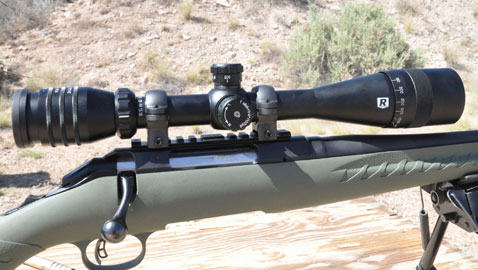
Once upon a time, Redfield scopes were an American icon. The company, founded in 1909 by John Redfield as the Redfield Gun Sight Company, produced American made sights and scopes for just shy of 90 years before going out of business in 1998. Having once established a reputation for producing quality riflescopes at reasonable prices, the brand suffered as several different companies bought and sold the name. In 2008 Leupold, makers of high quality optics and a rival of Redfield’s for many years, bought the Redfield brand and brought production of Redfield optics to their Beaverton, Oregon factory.
When I received the Ruger Predator rifle in .223 Remington caliber for testing I looked around for a suitable riflescope to set it up as a light varmint rifle. Redfield’s new Battlezone line of tactical scopes with their finger adjustable turrets, bullet drop compensator (BDC) dials and mil dot reticles seemed like a good fit so I ordered a 6-18 scope for the Predator. While researching the Battlezone scopes I also came across a new 2-7 variable with a BDC for the .22 Long Rifle (LR) and had to get that as well.
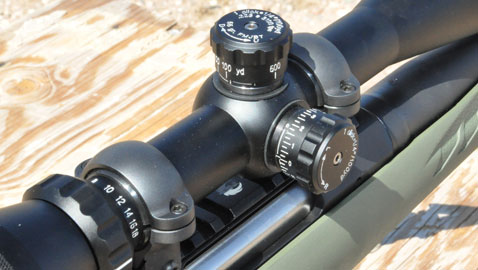
The 6-18X44mm Battlezone scope comes with a BDC for .308 Winchester, one for .223 Remington and a third dial for adjusting elevation with ¼ minute clicks, in other words, each click accounts for ¼ minute of angle which translates to about ¼ inch at 100 yards. The windage dial is also finger adjustable in ¼ minute clicks. Changing the elevation turret to the one you want to use is easily done by removing the screw in the turret with the included hex-wrench. But be careful, there is a small spring around the screw you don’t want to lose. The instruction manual covers this in detail and I recommend you look at it. Redfield calls the scope reticle a TAC-MOA reticle and it can be used for range estimating, holding off for windage and elevation and shooting at moving targets.
I mounted the scope with a set of 1 inch medium height rings and found there was plenty of eye relief even when set at maximum magnification. The view through the scope is bright and clear. I installed the .223 elevation BDC, which is calibrated for a 55 grain full metal jacket boat tail bullet at a velocity of 3100 feet per second (fps) and tested the rifle by firing four 55 grain loads with velocities ranging from 3155 to 3273 fps. After firing groups at 100 yards I used the BDC dial to shoot at 200 yards and 300 yards. This is a nice scope and I think it’s going to find a permanent home on the Predator. I still have some work to do getting it dialed in out to 400 yards and haven’t decided whether to stick with the BDC elevation dial or use the ¼ MOA dial but I’m leaning towards the latter. I may end up zeroing the rifle at 200 yards and working up how many clicks up and down I will need for 100, 300 and 400 yards. It’s nice to have these choices in one scope, especially one you can find for around $300.
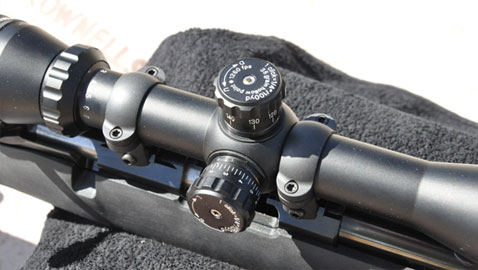
The Battlezone 2-7X34 is just like the 6-18, including the BDC, but it’s designed for .22LR rifles and retails for around $200. You probably wouldn’t have seen this setup several years ago, but now, with ammunition availability and prices being what they are, this idea makes a lot of sense and really expands what you can expect to do with a .22 rifle. The 2-7 includes two elevation dials, one with ¼ minute clicks and the other is a BDC calibrated for 36-grain hollow point ammunition at 1260 feet per second. This dial has settings for 50, 75, 90, 100, 110, 120, 130 and 150 yards. I installed the scope on a Ruger American Rimfire rifle that shares many features with the Predator and the 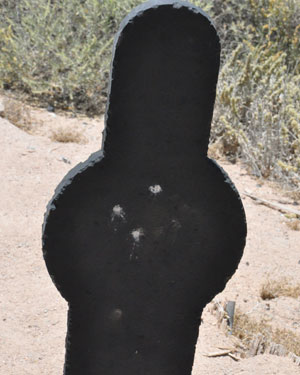 other rifles in the Ruger American lineup. At the range I zeroed the rifle at 50 yards then set out to see how the BDC worked with the several brands of ammunition. All .22s seem to prefer one ammunition over another but, even so, I was pleased to discover that selecting a range on the BDC got me very close to the point of aim all the way out to 150 yards. I was shooting on a 200-yard range so I thought, “Why not?” Shooting from prone off a bipod I turned the dial on the BDC, eventually ending up one full turn past the 150-yard setting. Shooting on a “power popper” a large Pepper Popper with a 12” center, I fired a 3 shot group then hiked down to the target and discovered a 3 shot, 3 inch group. Okay, I’m impressed. Not with my shooting, but with a rifle and scope combination that’s capable of this kind of accuracy at 200 yards – with a .22!
other rifles in the Ruger American lineup. At the range I zeroed the rifle at 50 yards then set out to see how the BDC worked with the several brands of ammunition. All .22s seem to prefer one ammunition over another but, even so, I was pleased to discover that selecting a range on the BDC got me very close to the point of aim all the way out to 150 yards. I was shooting on a 200-yard range so I thought, “Why not?” Shooting from prone off a bipod I turned the dial on the BDC, eventually ending up one full turn past the 150-yard setting. Shooting on a “power popper” a large Pepper Popper with a 12” center, I fired a 3 shot group then hiked down to the target and discovered a 3 shot, 3 inch group. Okay, I’m impressed. Not with my shooting, but with a rifle and scope combination that’s capable of this kind of accuracy at 200 yards – with a .22!
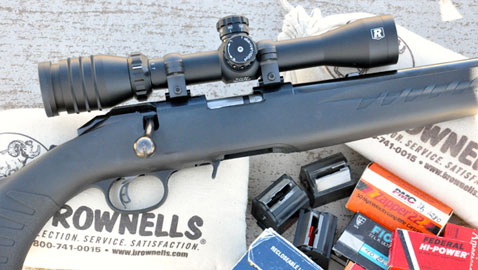
Setting up a .22 with the same handling and features as your hunting or varmint rifle makes a lot of sense from a training standpoint. It makes even more sense when you can do it at a reasonable price. The Ruger American rifle in centerfire or rimfire calibers with Redfield Battlezone scopes make for an accurate and affordable combination.
Reference Links:
www.redfield.com
www.ruger.com
About the Author:
 Ed Head is a regular on Shooting Gallery, Gun Stories and Down Range TV. He has worked for almost 30 years in law enforcement, first in the United States Air Force and then with the United States Border Patrol, retiring as a Field Operations Supervisor. During his Border Patrol career, Ed worked in a variety of patrol, investigative and training capacities. Ed has an extensive background as a firearms instructor, having trained thousands, ranging from beginners to police, military and special operations personnel. Having taught at Gunsite for 20 years, Ed first trained there under the world famous shooting school’s founder, Jeff Cooper, then later ran the school as the operations manager for more than five years. Ed lives in Chino Valley, Arizona, where he continues to teach and write.
Ed Head is a regular on Shooting Gallery, Gun Stories and Down Range TV. He has worked for almost 30 years in law enforcement, first in the United States Air Force and then with the United States Border Patrol, retiring as a Field Operations Supervisor. During his Border Patrol career, Ed worked in a variety of patrol, investigative and training capacities. Ed has an extensive background as a firearms instructor, having trained thousands, ranging from beginners to police, military and special operations personnel. Having taught at Gunsite for 20 years, Ed first trained there under the world famous shooting school’s founder, Jeff Cooper, then later ran the school as the operations manager for more than five years. Ed lives in Chino Valley, Arizona, where he continues to teach and write.
